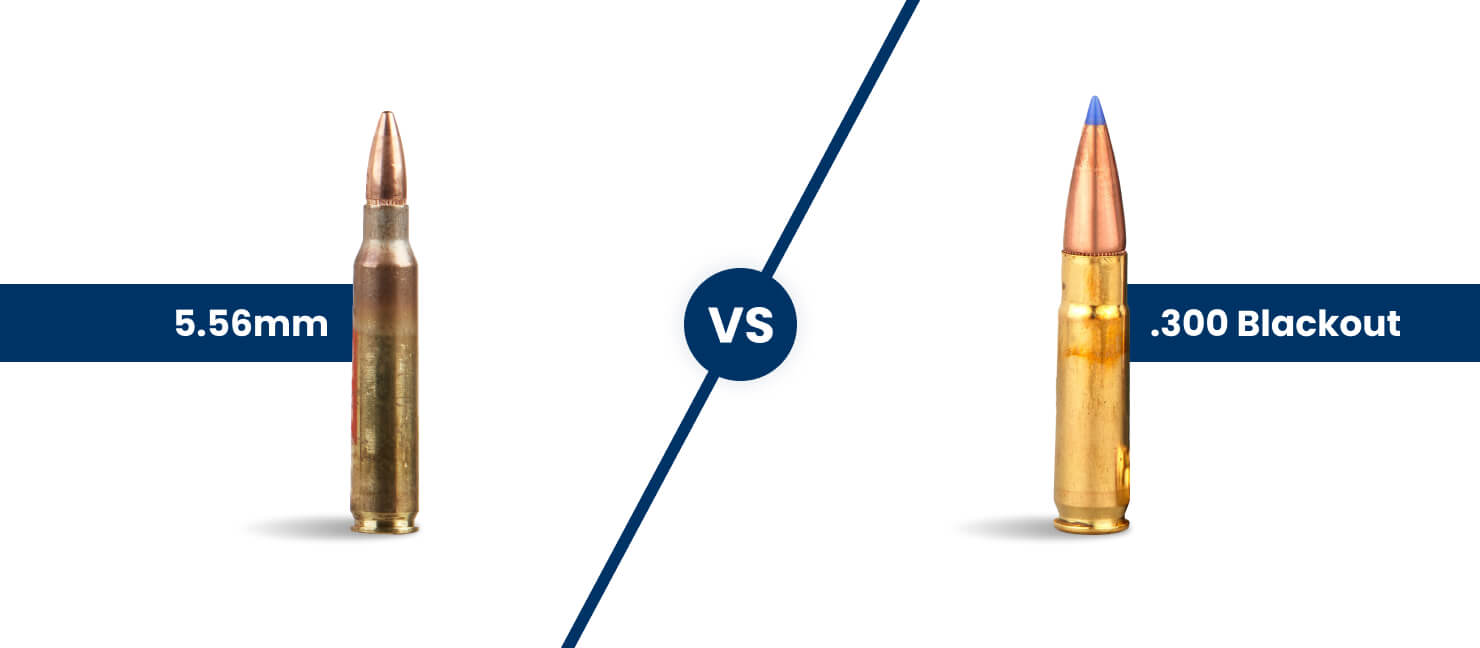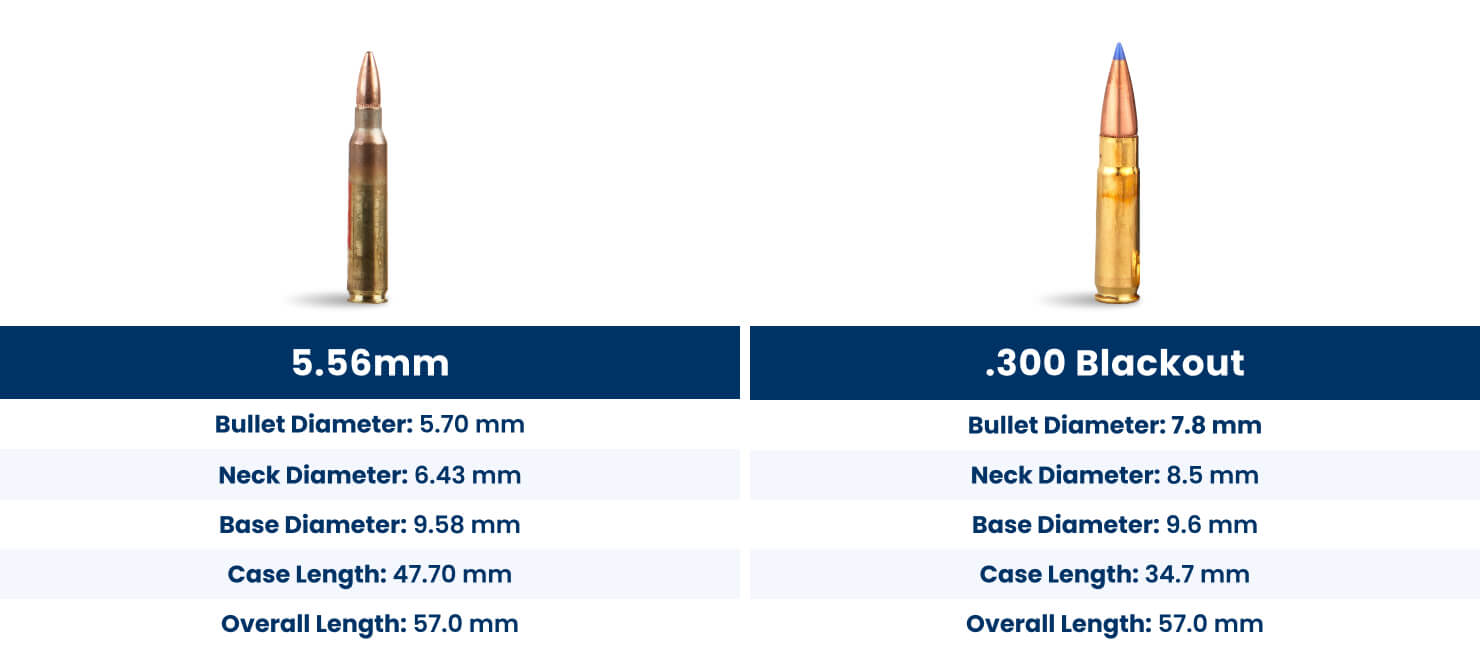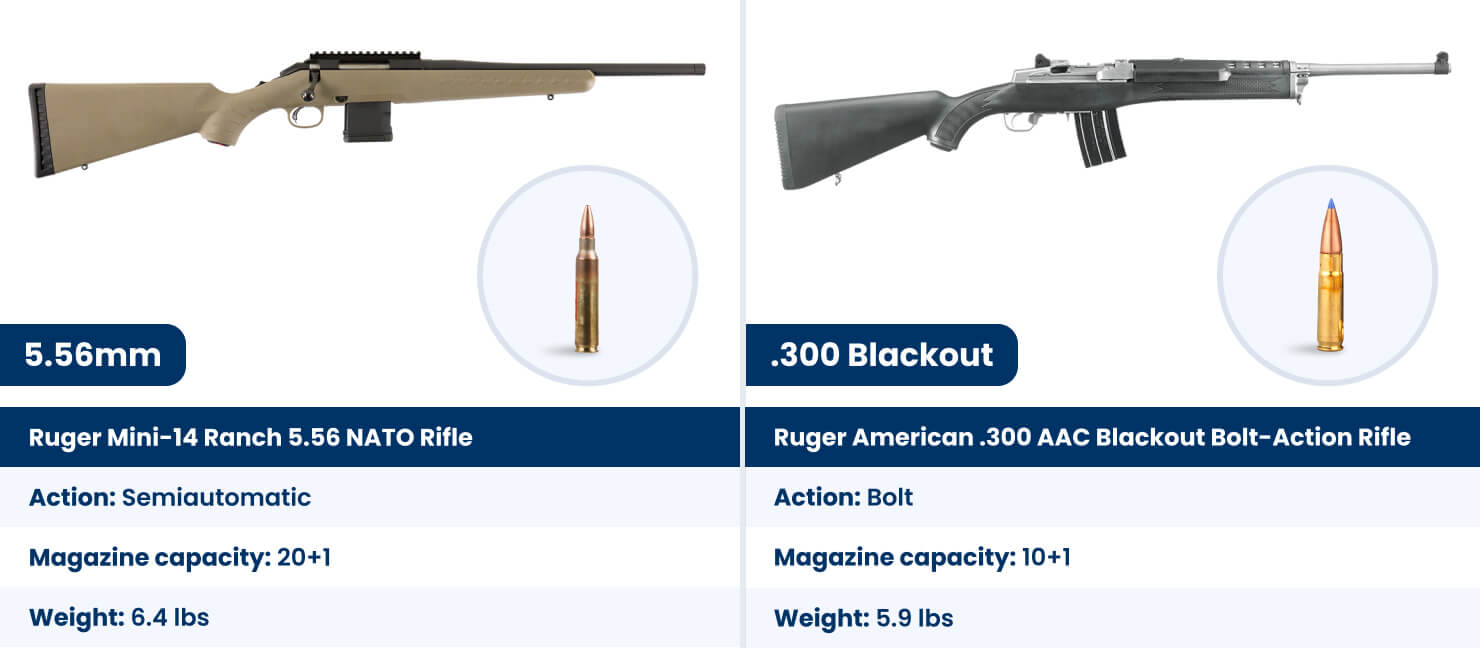5.56mm vs .300 Blackout: Which Rifle Cartridge is Right for You?

Are you seeking a rifle cartridge that suits your hunting and recreational shooting needs? The debate between 5.56mm and .300 Blackout rounds is a hot topic among enthusiasts! In this complete guide, we compare the 5.56mm and .300 Blackout to help you decide which cartridge is best for you.
Key Takeaways
- 5.56mm and .300 Blackout: History and Background: The 5.56mm was made to replace the .308 Win and is commonly used in a 16-inch barrel of a semiautomatic rifle. The .300 Blackout was made in the early 21st century to replace the 147-grain 9mm subsonic round for a bolt-action rifle.
- 5.56mm vs .300 Blackout: Specifications: The 5.56mm has a lower grain weight and performs better in longer barrels. The .300 Blackout has a higher grain weight and maintains a high velocity in shorter barrels at short distances.
- 5.56mm vs .300 Blackout: Pros and Cons: The 5.56mm has a flatter trajectory and less expensive ammo but is very loud with lower velocity. The .300 Blackout can be suppressed, making it subsonic, but has a steep bullet drop past 100 yards.
- Which Round Is Right for You? If you want a lightweight, inexpensive round and don’t mind the noise, go with the 5.56mm. If you want a quieter hunting experience that packs a punch and can afford more expensive ammo, choose the .300 Blackout.
5.56mm and .300 Blackout: History and Background
The 5.56mm round was first developed in the 1960s primarily for military use as a lighter and smaller round to increase magazine capacity and replace the 308 Win. The 5.56mm is also often called the 5.56x45mm, referring to the case length. You may also see it called the 5.56mm NATO, which indicates that the ammunition meets specific regulations specified by NATO.
Its widespread adoption by armed forces around the globe has cemented its status as a reliable choice for various shooting disciplines. The 5.56mm's dependable performance has made it a favorite among soldiers and civilian shooters who value its precision and versatility. Its long-standing presence led to widespread production. This availability makes the 5.56mm accessible to the average shooter.
Expert Tip:
The 5.56mm was created to work in the M16 which has a 20-inch barrel. The most common barrel length is now 16 inches, which has lowered the overall velocity of the round.
On the other hand, the .300 Blackout is a more recent invention, introduced in the early 21st century. Also referred to as the .300 AAC Blackout or 300 BLK, it was created to replace the 147-grain 9mm subsonic round, designed to switch between subsonic and supersonic loads without changing the firearm's configuration.
This unique capability makes the .300 Blackout particularly suited for tactical applications and hunting. The heavier bullet makes the .300 Blackout pricier and less readily available. This caliber appeals to a more niche audience. These shooters are willing to invest in its superior stopping power, maintaining terminal ballistics with 7-inch barrels and a suppressor.
Expert Tip:
The application of .300 Blackout is almost exclusively suppressed. If you want to bring down bigger game quietly, usually hogs, you have more time for follow-up shots and reduce the impact on your hearing.

5.56mm vs .300 Blackout: Specifications
Each cartridge offers distinct advantages and limitations, depending on the intended use, including range, power, cost, and firearm compatibility. We'll compare the specifics of both to help you decide which is the better option for your shooting needs.
5.56mm
The 5.56mm, or 5.56mm NATO, is known for its flat trajectory. Its range is reported to be between 200 to 500 yards, though it can fly further. It is economically priced and available in various loads for multiple applications, including match shooting, hunting, and personal defense.
The 5.56 is commonly suppressed as a supersonic round, but it is still not hearing safe. Its effectiveness also diminishes with subsonic loads and in firearms with significantly shortened barrels. Subsonic 5.56 rounds exist but don’t produce enough energy to cycle the bolt. It becomes ineffective for hunting larger game due to the reduced velocity.
.300 Blackout
The .300 Blackout offers flexibility for users seeking supersonic and subsonic ammunition capabilities. The .300 Blackout is particularly useful in firearms with shorter barrels. It excels in quiet operation with subsonic loads and suppressors, making it a favored choice for specific hunting scenarios.
The .300 Blackout is more expensive, particularly for high-quality subsonic and match-grade ammunition. Its performance at longer ranges can also be limited due to lower muzzle velocities than the 5.56mm.
Expert Tip:
The .300 Blackout is compatible with the AR-15 platform, but only with the appropriate barrel. Don’t put a .300 Blackout round into a 5.56 gun; it’s likely to explode
| 5.56mm vs .300 Blackout Specifications | |||||
|---|---|---|---|---|---|
| Category | 5.56mm | .300 Blackout | |||
| Usage | Versatile: military, law enforcement, sport shooting, home defense | Specialized: close-range, suppressed shooting, hunting | |||
| Ammunition Cost | Lower, widely available | Highler, less common | |||
| Stopping Power | Sufficient for most applications, less effective at close-range | Superior at close range, effective for hunting and defense | |||
| Range | 300 meters (effective) 500 meters (max) |
100 meters (effective) 460 meters (max - 16" barrel) |
|||
| Recoil | Lower, easier to manage | Firearms (such as AR-15) compensate for higher energy with a heavier internal weight or stronger spring | |||
| Barrel Length | Performs well in standard and longer barrels | Optimized for shorter barrels and suppression | |||
| Grain Weight | Common weights: 55, 62, 63 grains | Common weights: 78, 110, 125 grains | |||
| Case Measurements | Bullet Diameter: 5.70 mm /.224 in Neck Diameter: 6.43 mm Base Diameter: 9.58 mm Case Length: 44.70 mm Overall Length: 57.0 mm |
Bullet Diameter: 7.8 mm Neck Diameter: 8.5 mm Base Diameter: 9.6 mm Case Length: 34.7 mm Overall Length: 57.0 mm |
|||
Usage
-
The 5.56mm, round is widely versatile from military and law enforcement to sport shooting and home defense. Its widespread adoption is attributed to its range and relatively low recoil. This broad utility makes the 5.56mm a staple in the arsenals of shooters looking for a reliable round for many scenarios. The lower grain weight makes it easier to carry during hunting trips.
-
The .300 Blackout performs much better in short barrels and with suppressors. It’s excellent for taking down big game at short distances. It offers shooters the ability to switch between subsonic and supersonic ammunition without changing the firearm, making it ideal for situations that require a quiet yet powerful option.
Expert Tip:
If you’re looking into the automatic rifle platform, common barrel lengths for the AR-15 are 14.5 and 16 inches. Common SBR (Short Barreled Rifle) lengths include 10.8 and 11.5 inches.
Ammunition Cost
-
The 5.56mm round is an economical choice. Its prevalence in local gun stores and online retailers is bolstered by many ammunition manufacturers prioritizing the production of 5.56 and .223 rounds. This ensures a steady supply and keeps costs lower than more specialized ammunition.
-
In contrast, the .300 Blackout is more expensive due to its higher grain, specialized nature, and lower production volume. Prices for .300 Blackout ammunition can also fluctuate based on brand and other factors.
Range
-
The 5.56mm NATO is a lower grain weight and can travel longer distances. It has a flatter trajectory than the .300 Blackout. Despite its effectiveness at extended ranges, the terminal velocity is not effective past 100-300 yards. However, the cartridge's design is optimal for long-range plinking or target shooting and is much more effective with a longer barrel.
-
The .300 Blackout shines when fired from an AK47. It also performs in a 16-inch barrel, but these aren’t common. At 200-300 yards, it has nearly double the energy of the 5.56mm. In short barrel configurations, such as a 9-inch barrel, a 125-grain .300 Blackout round delivers 993 ft-lbs of energy at 100 yards, but has substantial bullet drop after that point.
Recoil
-
The 5.56mm round is popular among shooters of various skill levels partly because of its minimal recoil. This low recoil contributes significantly to better control and accuracy. The ease of handling and reduced physical strain also enhance shooter comfort and endurance, making the 5.56mm ideal for extended training sessions.
-
Despite its more pronounced recoil, the .300 Blackout is considered manageable and remains a preferred choice for many shooters. This is mainly due to the cartridge's significant stopping power and its versatility in suppressed and unsuppressed firearms.

Barrel Length
-
The 5.56mm NATO cartridge faces limitations when used with shorter barrels. The reduction in barrel length diminishes the 5.56mm muzzle velocity and reduces its maximum effective range while increasing bullet drop and wind drift at extended engagement distances.
-
The .300 Blackout retains more kinetic energy with a heavier projectile. This lessens the impact of velocity reduction and maintains a higher degree of penetration. This characteristic, its performance from shorter barrels, and its capacity to remain effective through common barriers position the .300 Blackout as a superior choice for short-range engagements.
Grain Weight
-
Standard grain weights for the 5.56mm NATO include 55, 62, and 77 grains. These lighter grain weights are needed to achieve the cartridge's high velocity and extended range capabilities. The availability of various grain weights allows shooters to tailor their ammunition choice to the specific demands of their activity.
-
The .300 Blackout cartridge offers grain weights such as 78, 110, and 125 grains. This cartridge focuses on delivering higher terminal velocity with superior stopping power at close ranges. The versatility provided by the .300 Blackout's range of grain weights allows it to excel in various scenarios.
Case Measurements
Despite differences in case dimensions, both cartridges share an overall length of 57.0 mm, which is a critical factor in their compatibility with firearms designed for the .223/5.56mm platform.

-
The 5.56mm NATO cartridge’s diameter of .224 inches or 5.70 mm is on the smaller end of rifle calibers and optimized for high velocity. The base diameter of 9.58 mm contributes to its stability, case capacity, and efficient powder burn. The overall length of the 5.56mm NATO is 57.0 mm, ensuring it fits well within standard rifle and AR pistol platforms.
-
The .300 Blackout cartridge has a larger bullet diameter of 7.8 mm designed to optimize energy transfer. The base diameter is very close to that of the 5.56mm, at 9.6 mm. However, it distinguishes itself with a shorter case length of 34.7 mm. This compact design is advantageous for both suppressed and unsuppressed use.
Expert Tip:
You can use both 5.56mm rounds and .223 Remington rounds in a 5.56 rifle. The 5.56 has more gunpowder. However, you cannot put 5.56 ammo into a .223 firearm.
5.56mm vs .300 Blackout: Pros and Cons
5.56mm Pros
|
.300 Blackout Pros
|
5.56mm Cons
|
.300 Blackout Cons
|
Which Round Is Right for You?

Choosing between 5.56mm and .300 Blackout rounds depends on your shooting needs. The 5.56mm round is lighter and more affordable, making it suitable for many activities. Many prefer the 5.56mm for sport shooting, plinking, and professional use. The lower recoil aids new shooters by offering comfort and ease of handling for prolonged sessions.
On the other hand, the .300 Blackout is a prime choice for applications where stopping power and a quieter hunt are critical. Its use in a short barrel with a suppressor is highly effective. This round caters to shooters willing to invest in higher ammunition costs for these specific benefits.
Have Fun Out There!
Seeking precision and power? Explore our extensive selection of 5.56mm and .300 Blackout ammunition. Whether it's the long-range trajectory of the 5.56mm or the hard-hitting force of the .300 Blackout you're after, Academy Sports + Outdoors has you covered with top brands at the best prices.


